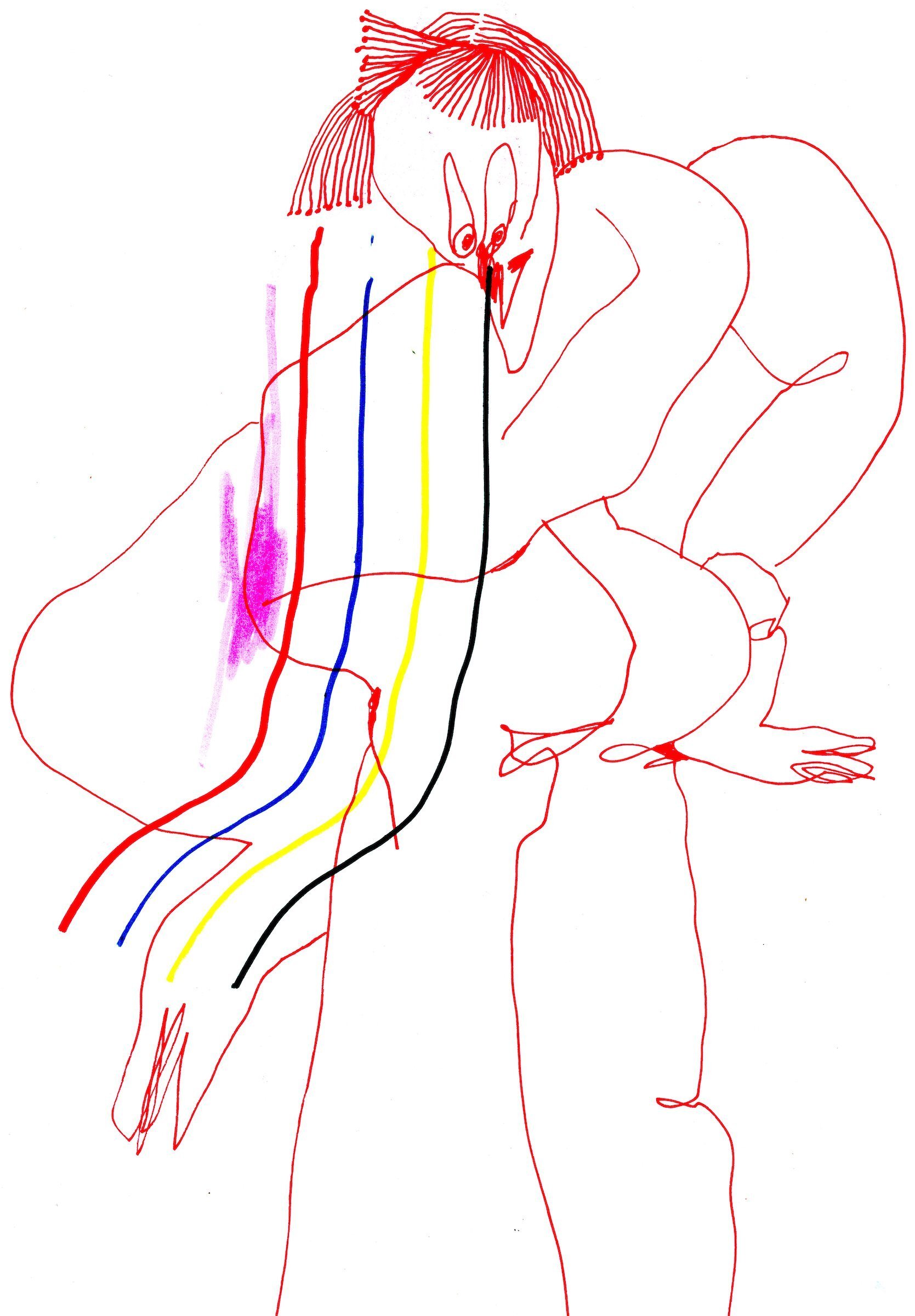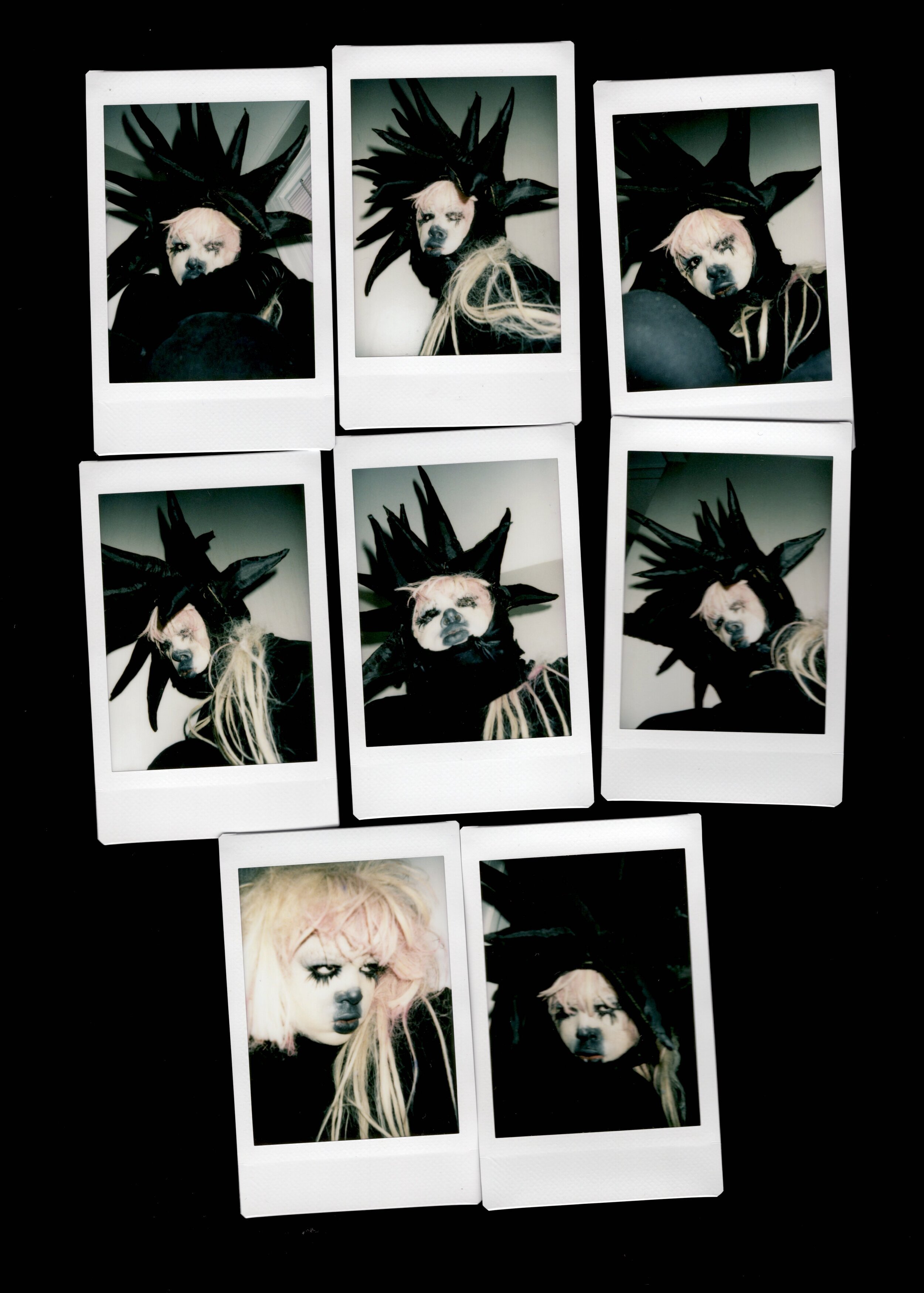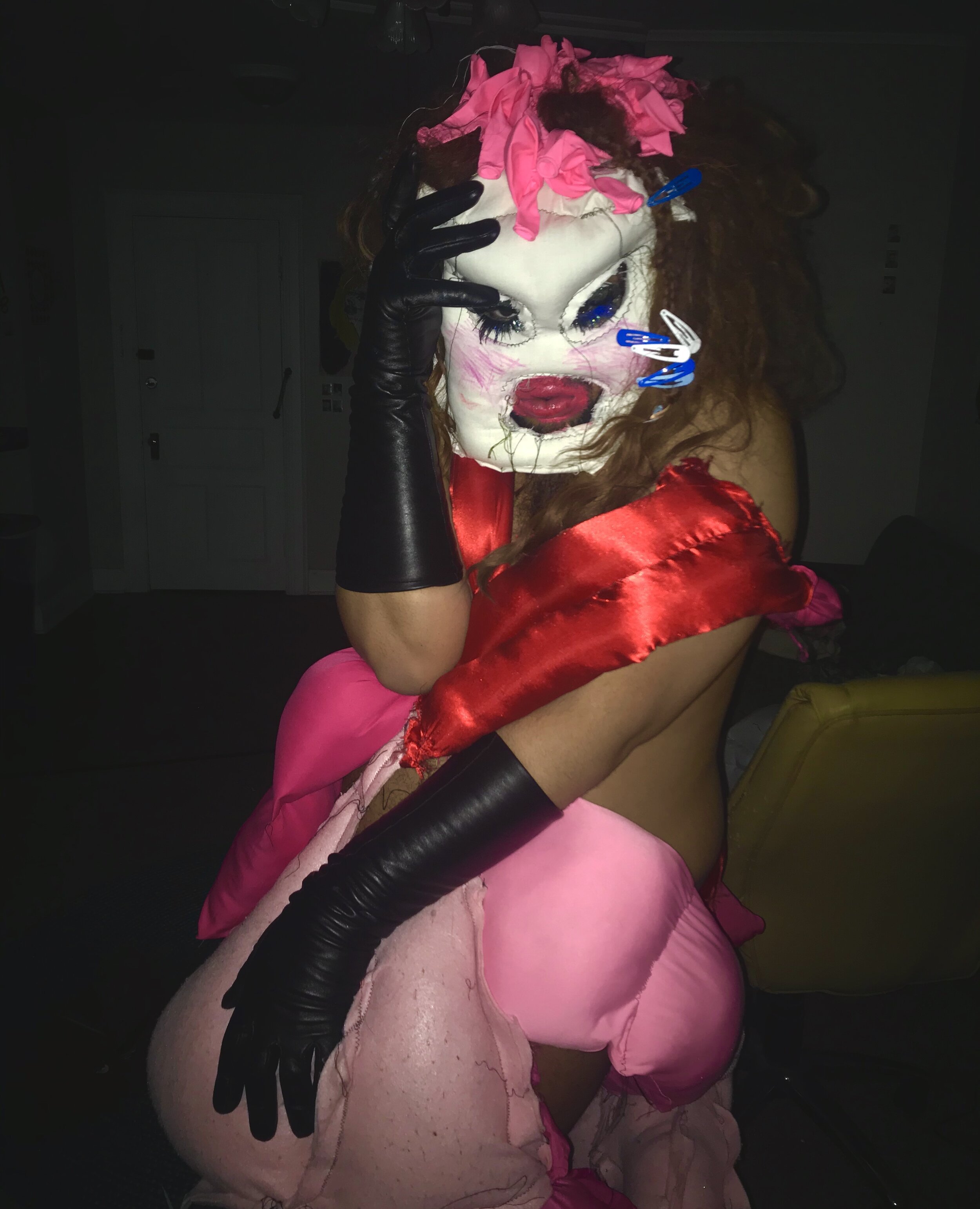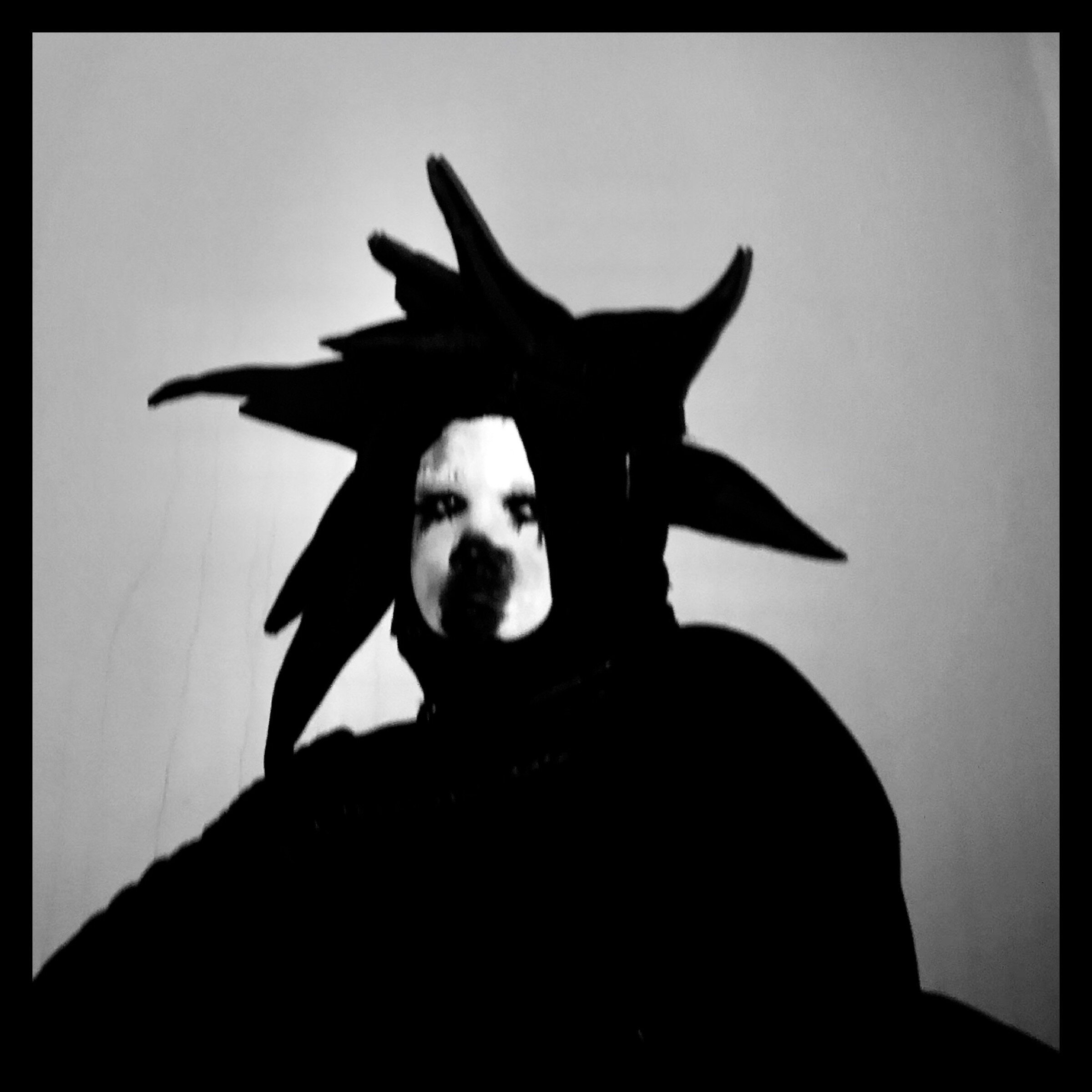Vulnerability in the Club: Ryan Huff in Conversation with Kyla Kegler
by :
Kyla Kegler
pretty pillow princess, i have a strong crush on a couple people, 2020. Ink on paper, 8.5 x 11 inches. Courtesy of the artist.
Ryan Huff is a twenty-seven-year-old artist raised in Hannibal, New York, and currently based in Buffalo. Huff’s practice incorporates drag, performance, fashion, and drawing. The characters of the artist, who identifies as half white and half black, thoroughly observe this precarious middle ground with layered expressions of equal parts agony, ecstasy, and hilarity.
Huff’s drag persona, pretty pillow princess, is often found pouting in a blonde wig, lipstick smeared well around her actual lips, and a thick layer of peachy flesh toned foundation impressing a bold contrast against Ryan’s hairy brown skin. Posing in unapologetically submissive positions and projecting an assertive gaze straight back into the lens of her iPhone that confuses the empathy-response in her audience, pillow princess is not a victim.
In his drawings, Huff intricately depicts specific tensions within and among figures. His linework is characterized by a single, feeble, wandering line that sometimes rejoins itself to form a space filled in with solid color. These solid moments punctuate the frenetic instability of his little worlds drawn with micron pen on scrap paper, providing anchors on which to rest or voids in which to be swallowed.
The deformed bodily proportions of his characters amplify feelings his conversational titles describe:
a child commanding a dog to move (2019)
great, can we go now? (2019)
hard and soft on myself (2019)
I lost control so easily what a shame… (2019)
must’ve scared you off (2019)
I have a strong crush on a couple of people (2019)
Rooting his subject matter in feelings from personal conversations and relationships, Huff engages contemporary culture through confessionalism, the vulnerability revolution, and the historic legacy of drag performance. Huff’s highly stylized gestures subvert and reclaim the African-influenced aesthetics of colonizer primitivism popularized by artists of the Parisian avant-garde (Picasso, Matisse, etc.) in the early twentieth century, spun through now with humor, kitsch, and personal anxiety.
Over two conversations on August 4 and 10, 2020, Huff and I spoke about his person and persona, his influences and performances, his drawings, and his business. Our conversation has been edited for brevity and clarity.
You can find Huff’s work on his drag instagram, his 2D work instagram, and you can buy his merch on Teespring!
On Artist Names
RYAN HUFF
I went through about a million names: I was “dumpster dive” back in college, then I was “mr. hoax,” then “mr. miss,” then “bendy bitch.” And then I was “pchy fleshtone,” and now I'm pretty pillow princess. pchy fleshtone came from the color of foundation I use. I was inspired by a Grace Jones picture shot by Jean-Paul Goude in the 1980s where she was painted from the shoulders up as a white person. It really resonated with me because I'm half white and half black. So I decided that I was going to always use the same foundation and just make that my drag character. pchy fleshtone — the makeup — is kind of like that pinkish skin color that a lot of cartoon characters have. I was going by pchy fleshtone for a while, but I felt like I was seeing a lot of peach-based imagery and it was annoying so I was like, “Now I’m changing it.”
pretty pillow princess, made to order, 2020. Ink on paper, 8.5 x 11 inches. Courtesy of the artist.
KYLA KEGLER
Peach emojis or peach color?
RH
Both! They were such a trendy thing, and in gay culture the peach emoji is like an ass, which is fun but I felt like it was time for a change. So now I’m pillow princess. I like that it’s first and foremost an object, a pillow, and then that it’s kind of a sexual innuendo. It’s tongue in cheek, but the idea of a pillow being soft and my last name being princess — it felt delicate and vulnerable. Vulnerability is kind of the biggest thing I go back to in my work, so I just thought it was perfect — an object, sexual innuendo, vulnerability, I checked all the boxes!
I changed my name at a time when I felt like I didn't know what I was saying anymore and I was growing out of old ideas and into new ones. So when I changed it to pillow princess I was like “Okay, what can I do with that to really tie it all together visually with a name?” So I thought, “Why not just make pillow things and add straps to them?” Anything you can put on your shoulders is a garment. It was a nice transition because I went to school for ceramics and sculpture and really fell in love with the challenge of thinking in 3D instead of just 2D. So now all of my garments are kind of sculptural and I can feel like my college was for something.
On Drag / Performing
RH
I've dabbled in makeup and drag stuff for years, maybe since like 2012 or 2013. And when you're a drag queen, you feel like you're required to start performing live and onstage and doing shows and all that. So I was doing that for about a year before COVID happened. I feel like all the art I do is just for me and it's very greedy and that's kind of how I like it. I can't perform a character unless I’m obsessed with it to the point where I can lose myself in it. If I have an audience, great, if I don't, I'm still performing in my living room.
But I was beginning to really enjoy performing on stage and getting ready — taking Uber to the club, going backstage, that whole ritual, and then performing and getting tips and stuff. For performers, COVID has robbed us of the experience of watching people experience us. That was the most exhilarating part. So when I perform online it's still fun, but it doesn't hit quite the same. There's some life that was taken out of it.
KK
What does performing feel like?
RH
Oh my god. It's hard to explain, because it feels so intense and then afterward when you try to recollect how it feels you can't remember. In a way you have to perform to even feel it again, but the closest thing I can say is it's the most cathartic thing I've ever done — the least nervous I've ever felt is onstage. It's the build up — I get very nervous and then once I’m out there it's so easy. And I do feel like a different person. And that feels like the essence of drag, once you can completely feel your character and your vision. Yeah, there's really nothing like it.
pretty pillow princess, Inkblot, 2020. Polaroid collage. Courtesy of the artist.
KK
I hope that we can be in physical proximity again one day. I think that aspect is sad but also has lots of potential.
RH
Absolutely, and everything now is a political statement no matter what you do. If you were a performance artist before this, the performances you’re now doing online because of COVIDare going to be an archive of news events and art and feelings made in response to them. No matter what you do, it's gonna be a statement of the times. That's a good thing.
Daily-self vs Drag-self
KK
There’s a pretty incredible contrast between Ryan Huff the person, who is a very deliberate, conscientious, and a poised communicator, and pillow princess, who presents as an uncontainable, tenderly confrontational, unapologetic mess. Can you talk about the difference between your daily self and your drag self?
RH
I've realized that the older I get, the less of a gap there is between the two. My performance in my everyday life is very much to myself and quiet, and I can get somewhat shy and in my head. I think that's pretty typical for a drag performer. pillow princess is a little bit of a quieter experience, but she's just kind of there and she's not that self aware. I feel like in drag, I know what other people are thinking of me so I don't really care, but then as a person I'm very much concerned with what people think and I'll never actually know.
KK
It's interesting that you say that your drag persona is quiet because I can see that in her actions and postures, but the visual impact is anything but! When I think of your work in drag, it’s just so in my face in the best way possible.
RH
I think where that comes from is that I really like vulnerability, and specifically I like the idea that it's beneficial to be vulnerable but also it can be extremely dangerous. And when I think of danger, I think of energy and stress and just clashing ideas. So I think that it all mixes and comes through. And it looks a bit childish and naive because a big part of being vulnerable is kind of maintaining some sense of innocence.
KK
Based on my past failed attempts to buy your work and collaborate with you, my impression is that you're extremely careful and selective about how and with whom you share your work. Can you talk about that?
RH
It really does come down to it being a racially charged thing. As an artist of color, I'm constantly worried about my work being stolen or posted without crediting me or anything like that. I'm afraid of being pillaged because my work really is all that I have and it's something that I've developed over my entire lifetime up until this point. So a lot of it is paranoia, and I have definitely come to a point where I know my fears are justified, but I can't let it stop me from seeking out people that I trust and I understand that collaboration is extremely necessary to any artist of any medium and I am no exception. Slowly but surely I'm stepping out there but it's very cautious; I'm like an overly protective mother and my work is like an angsty teenager begging me to let it go out and party. So I’m just trying to let it, more and more.
Draw Draw Draw
KK
The way you title your drawings, each one feels like a very specifically relatable confessional-esque story. Can you describe your titling process?
RH
I just draw, draw, draw — it's really integrated into my life; especially when I was working pre-COVID, I would just go to a coffee shop and draw. Usually I was pretty emotionally charged for one reason or another working at the Lexington Co-op. I would get my coffee, draw, and then let the drawings pile up. I wouldn't look at them for a while because I never like what I draw right away, but it's like, “Okay maybe there's something there, so let me set it aside.” So I end up with a big stack of stuff and then I'll look through it and ask myself what was I going through, what that conversation would have been if I fully remembered it. The titles are my best guess at what I was feeling at the time, and I try to make them as conversational as possible. I like an obnoxiously long title, like it's an excerpt. It's kind of like a mix-match. As if you found shreds of paper and tried to put them together to make a diary — that's kind of what it is.
pretty pillow princess, Untitled (Documentation of drag performances), 2020. Courtesy of the artist.
On Colonizer ‘Primitivism’, the Ethics of Performing Diversity, and Being Inspired by What’s Going on
KK
Your abstracted characters are visibly built on a sophisticated understanding of the human figure. Do your drawings intentionally reference a primitive aesthetic?
RH
I remember one of my teachers saying that to me in school — they're like, “Well you're not really primitive because you're in school and you're educated.” To a certain extent, that's true, you can never go back. For example, in any kind of relationship, if something happens and it changes, you can’t ever go back. You just have to take everything you have going forward and say, “How do I add to what I have, because what I have is what I trust and I need to trust that it will develop.” You can't think about it too much, you just have to be okay with whatever comes out.
I feel like it’s something for each individual artist of color to decide. I got really caught up for a while in the idea of what if someone asks me about my experience as an artist of color and I say the wrong thing and represent all my people the wrong way, but it's really not like that. It's individual, and for me, I like sharing my art and I’m hoping that people respond to it. I really like the idea of being respected by other artists, that's really important to me too.
It's interesting because I don't have to worry about my work being racist in the same way as a white person would. Like I can make my face white and not worry about it offending white people or exploiting whiteness since I’m half white and there's no malicious history behind white face. For me, I come from the school of thought that you just have to be prepared to have your art not be received in a nice light, but you can never make work that you feel like you have to apologize for. But it's delicate and I definitely don't have the answer.
I've had this conversation with a couple of my white artist friends. And it's sad because I feel like the fear that comes from this kind of conversation prevents some kind of truth or the freedom to just put out what you want to put out. But I guess it's still good to contemplate and think about it critically. That's the great thing about making characters or having different tones to talk in — not necessarily hide behind them, but it gives a representation to the purpose. I don't know if that makes sense. But it's good to have those talks. Art isn't meant just to make you feel comfortable or good.
pretty pillow princess, can’t fall again, 2020. Pencil on paper. Courtesy of the artist.
KK
And you said that your drawings are not for sale?
RH
I did say that! Yeah. At least the small sketchbook pen drawings I don't really sell. But I do sell other stuff, like the shirt I'm wearing right now.
It's weird because I feel like when you hear it's not for sale, you would think, “Oh they're really precious to you.” But it's kind of the opposite: they're not precious to me at all. I have piles and piles and boxes and drawers full of drawings. I feel weird about accepting money for my art. Why are you buying this thin piece of paper with lines on it? It just seems weird to me. So I don't sell them because it feels weird. Even though I know people want them. They're also precious to me on the opposite side of it. It's both, I don't know.
KK
Quality images of your highly coveted drawings that are not for sale?
RH
Highly coveted! Yes!
KK
When you decide to sell them let me know.
Thank you so much for this generous conversation, I think we got some meat!
Is there anything else you want to say about you and your work?
RH
Look out for me!
pretty pillow princess, inkblot, 2020. Digital Photograph. Courtesy of the artist.






